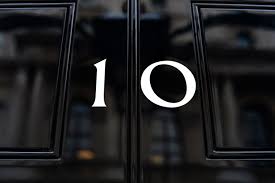You have no items in your shopping cart.
Last Updated: March 2024
Ever wondered who opens the door at Downing Street? Why is the door black? Why is the zero wonky? Since we love all things door hardware related at tradefit, we thought we’d take a look behind the scenes of the world’s most famous front door.
History of 10 Downing Street

Originally one of three houses, Downing Street was gifted to Sir Robert Walpole by King George II in 1732. Walpole accepted the gift on the basis that it would be used as the office of First Lord of the Treasury – a post he held at the time while effectively serving as Prime Minister. Thus a centuries-old tradition was born.
In fact, the brass letterbox on the front door is still engraved with the title “First Lord of the Treasury”.
Number 10 as we know it started out as Number 5 and wasn’t renumbered until 1779 – prior to this, houses in the street tended to be known by the name or title of their occupants.
Did You Know: The street was named after Sir George Downing, who built it in the 1680s on the site of a mansion with the intention of building townhouses “for persons of good quality to inhabit”
Rebuilding Number 10
Although Number 10 was the Prime Minister’s office it was generally used for working or social purposes and not a main residence. In fact, in 1839 there were plans to demolish Number 10 and the other buildings to make way for a remodelled Whitehall, as the house and surrounding areas fell into disrepair. In 1868 Benjamin Disraeli persuaded the state to pay for the redecoration of the public rooms and paid for refurbishment of the private rooms himself. Central heating was installed in 1937 when the attic rooms were converted into a flat for the Prime Minister.
Paint It Black
While we have always known it as black, the famous Downing Street door was not always that colour. Prime Minister Herbert Asquith repainted it dark green during his occupancy in 1908 – dark green being a fashion of the time.
The original black oak door was replaced by a blast-proof reinforced steel one after the IRA mortar attack in 1991 - apparently a splinter from the blast is still embedded in the upstairs plasterwork. The door is regularly removed and replaced for refurbishment and is so heavy it takes eight men to lift it.

Where’s The Door Handle?
While the iconic lion door knocker still functions, the door itself cannot be opened from the outside – hence no door handle. It can only be opened from the inside by the guard on duty, who monitors a screen to know when to open the door. Look closely and you’ll notice there’s no keyhole either (no worries about losing the keys then).
Did You Know: The recognisable lion door knocker is actually made of brass and painted black. It was originally added to the door by Lord North during his time as Prime Minister between 1770 and 1782.
A Wonky Zero
The door numbers were painted on the door during major renovations in the 1960s.
There are many theories about why the zero is angled left at 37 degrees – many think it’s a nod to the original door design (and the poorly hung numbering). Others believe the ‘0’ is in fact a capital ‘O’ as found in the Roman’s ‘Trajan’ alphabet that was used by the Ministry of Works at the time.
Another theory is that when you look down the street from Whitehall the 0 looks straight. Either way, it doesn’t look like the trend has caught on…
Did You Know: You can see the original door on display at the Churchill Museum in London.

Sources
https://en.wikipedia.org/wiki/10_Downing_Street
https://www.gov.uk/government/history/10-downing-street
https://typefoundry.blogspot.com/2010/10/number-ten.html
Feeling inspired? While you're here, why not check out our range of Front Door Furniture and Door Hardware













